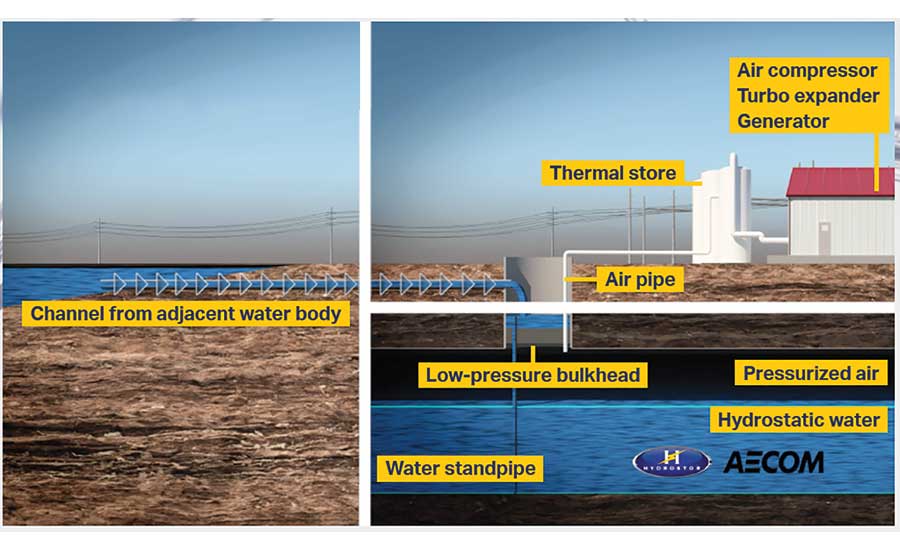AECOM is teaming up with Canadian start-up Hydrostor to get a foothold in the booming energy storage market. Under the deal, AECOM is licensing Hydrostor’s Terra technology and serving as EPC for projects the companies develop.
The technology uses the principles of compressed-air storage. But by drilling deep underground caverns and filling them with water, it creates an isobaric environment that improves the efficiency of the process.
Energy storage is one of the fastest-growing segments of the electric-power industry. Earlier this year, Morgan Stanley said the battery storage market is “underappreciated” and that the “addressable” U.S. market for energy storage could hit $30 billion.
According to analysis by the Energy Storage Association and GTM Research, the U.S. energy storage market grew year over year by 284% in 2016 and is on track for more exponential growth in 2017.
“We are still assessing the market size,” says Travis Starns, AECOM’s business development manager for energy storage. He notes that, in round numbers, “we’re looking at a $1-billion opportunity.”
In discussions about potential projects with several utilities, AECOM and Hydrostor also are eyeing opportunities at up to 80 coal plants targeted for closure. A project could be in operation in two or three years, but Starns anticipates that an engineering services contract could be signed in 2017 to evaluate the technical challenges and commercial feasibility of the technology.
The cost of the technology depends on the size of the project, but with Terra technology, “bigger is better,” says Starns. The first demonstration-commercial project could total about 100 MWh, with a price tag of at least $25 million, he says.
The energy storage market is being driven by steep declines in technology costs and a growing need to smooth out the intermittency from the growing amount of wind and solar power generation.
Compressed-air energy storage (CAES) and pumped-hydro storage—in which water is pumped up to a holding reservoir when demand and electricity prices are low and discharged when demand and prices are higher—are better suited to the longer-duration market but are expensive. Hydrostor’s technology is a hybrid of CAES and pumped hydro storage.
Hydrostor started by pumping air into balloons, deep under water. The water pressure improves the efficiency and economics of compressed-air storage, but the company realized its market opportunities were limited by the need to be close to deep water.
Hydrostor’s Terra technology involves drilling about 400 meters deep, creating a shaft that ends with a cavern that ranges from 50,000 cu m to 400,000 cu m, depending on a project’s energy requirements.
The shaft and cavern are filled with water from a nearby source. Then, air is pumped into the cavern, displacing the water. The water ensures that the compressed air entering and leaving the cavern is at a steady pressure, which enables the air compressor to operate more efficiently and economically. Eliminating the dead zones that occur in CAES, it also allows for a deeper discharge cycle.
Stripping the heat that is created when air is compressed, Hydrostor stores it in an aboveground thermal exchange unit. The air passes through the heat exchanger on the way to the turbines that drive the generator. CAES technology burns natural gas to heat the air before it enters a turbine. “It’s a clever and unique approach that provides long-duration storage with no emissions,” says Starns. The result is a storage technology that fits the needs of the underserved long-duration market while using proven mining technology and off-the-shelf components.
Hydrostor CEO Curtis VanWalleghem says the Terra technology can provide energy for between eight and 12 hours at half the cost of batteries and on par with the cost of a new gas-fired power plant.
VanWalleghem says about a third of the coal plants proposed for closure are suitable for conversion to storage projects.
Starns says the partnership plays to AECOM’s strengths as an EPC firm and leverages the work it has done for utility clients on existing fossil-fuel plants. Further, by packing together proven components, the Terra technology has the potential to turn a cutting-edge energy storage installation into “a piping project,” Starns says.



Post a comment to this article
Report Abusive Comment